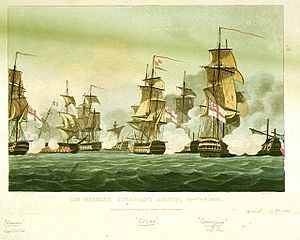HMS Courageux (1800) facts for kids

Plan of HMS Courageux by John Henslow in 1797
|
|
Quick facts for kids History |
|
|---|---|
| Name | HMS Courageux |
| Ordered | 6 November 1794 |
| Builder | Deptford Dockyard |
| Laid down | October 1797 |
| Launched | 26 March 1800 |
| Fate | Broken up, 1832 |
| General characteristics | |
| Class and type | 74-gun third rate ship of the line |
| Tons burthen | 1772 (bm) |
| Length | 181 ft (55.2 m) (gundeck) |
| Beam | 47 ft 1 in (14.4 m) |
| Depth of hold | 19 ft 10 in (6.0 m) |
| Propulsion | Sails |
| Sail plan | Full-rigged ship |
| Armament |
|
HMS Courageux was a powerful warship of the Royal Navy. It was a "74-gun third rate ship of the line," meaning it had 74 cannons and was one of the main types of large warships used in battles. This ship was built in Deptford, England, and launched on March 26, 1800. It was designed by Sir John Henslow and was special because it was the only ship built exactly to its unique design. Unlike many other 74-gun ships, Courageux carried heavier 24-pounder cannons on its upper deck, making it a very strong vessel for its time.
Contents
Building a Mighty Warship
The construction of HMS Courageux began in October 1797 at Deptford Dockyard. It was a large ship for its time, measuring about 181 feet (55 meters) long on its main gun deck. It had a wide beam of 47 feet (14.3 meters).
Courageux was a Full-rigged ship, meaning it had three masts with square sails. It relied entirely on wind power to move. Its main weapons were its many cannons:
- 28 large 32-pounder guns on the lower deck.
- 30 powerful 24-pounder guns on the upper deck.
- 12 smaller 9-pounder guns on the quarterdeck.
- 4 more 9-pounder guns on the forecastle.
Early Missions and Encounters
In January 1804, Courageux accidentally ran into another ship, Atalanta. This caused Atalanta to have to stop at Dartmouth for repairs.
Earlier, in January 1801, a French fleet with seven warships and two frigates, carrying 5,000 soldiers, escaped from a port in France. A British ship spotted them and reported the news. Thinking the French were headed for the West Indies, a British fleet of similar size was sent to chase them. Courageux was chosen for this mission because it was one of the fastest warships available.
Battles in the Caribbean
When the Peace of Amiens (a peace treaty) ended in May 1803, Courageux was part of a British fleet in the Leeward Islands. This fleet was led by Samuel Hood.
In June 1803, Courageux took part in an attack on the island of St Lucia. The fleet left Barbados on June 20. They were joined by other ships the next morning.
The British fleet anchored in Choc Bay around 11:00 AM. Soldiers were landed by 5:00 PM, and the town of Castries quickly surrendered. The main fort on the island, Morne-Fortunée, refused to give up. So, the British soldiers stormed it early on June 22, and by 4:30 AM, it was captured. After taking St Lucia, the British force invaded Tobago, which surrendered on July 1.
Protecting Merchant Ships
On January 1, 1804, a group of merchant ships, called a convoy, left Portsmouth, England, heading for the West Indies. Courageux was part of their escort, protecting them from enemy attacks. On February 1, 43 of these ships returned to Plymouth, still with Courageux as their escort.
In mid-1804, Courageux escorted another convoy from St Helena back to Britain. This convoy included large trading ships called East Indiamen, like City of London and Ceylon. It also had ships that had been to the South Seas and one, Rolla, that had carried prisoners to Australia.
During this journey, the convoy faced very bad weather. One ship, Prince of Wales, sank in the storm, and everyone on board was lost. This showed how dangerous sea travel could be, even with a powerful warship like Courageux protecting the convoy.
Famous Battles and Later Years
On November 4–5, 1805, Courageux was involved in an important naval battle called the Battle of Cape Ortegal. This battle is also known as Sir Richard Strachan's Action.
From 1806 to 1807, Courageux was commanded by James Bissett.
Soon after the War of 1812 began, on August 12, Courageux helped capture several American ships. These included vessels named Cuba, Caliban, Edward, Galen, Halcyon, and Cygnet.
Fate
In 1814, Courageux was assigned to harbour service, meaning it stayed in port and was no longer used for active sea duty. The ship was finally taken apart, or "broken up," in 1832.


